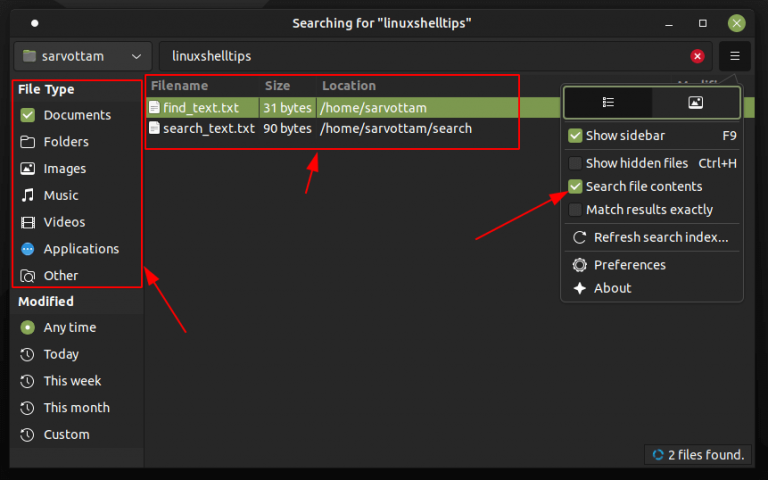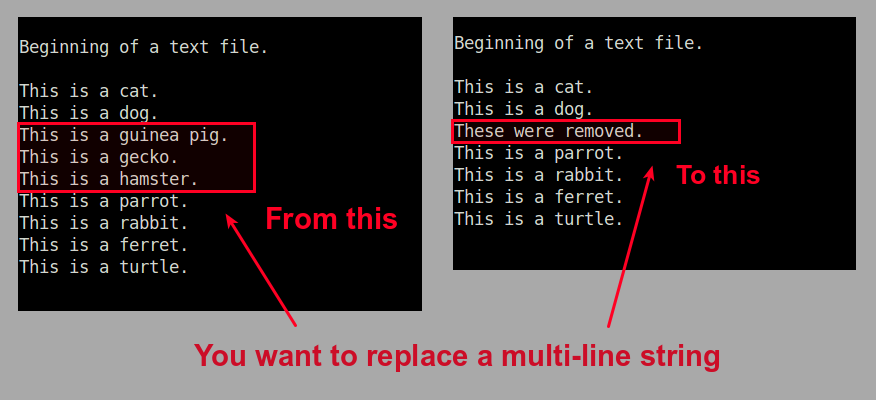

You might also be interested in: How To Repeat A Command Every X Seconds On Linux If you don't want to search in the current folder, but in a specific folder, you can specify the path in which grep should look into, by adding it at the end of the command, like this: If you only want to list the filenames containing the exact whole word text (as opposed to the default partial word matching), and not things like texting, 123text, and so on, you'd need to append the -w (whole words) command line option, like this:

If you require following all symbolic links, use -R instead of -r. r stands for recursive, reading all the files in the directory and its subdirectories. This includes strings like texting for example, because it contains our search pattern, text. This lists all the files in the current folder and subfolders containing text. To do this, you need to open the terminal, navigate to the folder where you want to perform the search, and run: Say you want to search for the word text (case-sensitive!) in all the files in the current directory and its subdirectories. Grep is a command-line utility which prints lines that match a given pattern, and should be installed by default. For this we'll use grep, a standard Unix program. With this information, you can now quickly locate files on your ServerMania hybrid smart server or dedicated server.This article explains how to find all files containing specific text on Linux. You are now familiar with the find and locate commands on Linux. Locate *.html > listoffiles.txt Conclusion You can use pipe or redirect to take the standard output of the locate command and send it to the standard input of another command, or to file: You can also use the wildcard characters, such as *. To locate files only on the name of the actual file, use the –basename option: The database can be manually updated by running the following command:īy default, this will return any file that has the string “filename” in its location. It can be installed by running the following: The locate command builds a database of files on the system, so searches tend to be faster. The -exec command allows you to execute an action against all of the files that are output from the find command.įind a file named file1 and change permissions to 644:įind / -name “file1” -exec chmod 664 How to Use the Locate Command On LinuxĪn alternative to the find command is the locate command. In order to find a file that is exactly 1GB in size, simply type in the phrase:įind / -size -1G Performing Actions based on Find Output

SImply use the -size flag with the following size conventions: This will list all files with 755 permissions:įind can filter files based on their size. We can even find files based on permissions. The -user and -group flags can be used to find a file located by a specific user or groupįind all files owned by group “mc” with the case sensitive name “mirrorlist.txt” Let’s find a file modified more than 5 days ago:įind / -mmin +25 Finding Files by User or Group You can find files based on access time (-atime), modified time (-mtime), and change time (-ctime) flags. In order to find a regular file called “file1” use:įind -type f -name “file1” Finding Files by Time If you want to search for files by type, you can do so with the following command: This will return all files that don’t contain the string “file” in them, and is applicable to other strings. What if we only want to return files with names that don’t contain a certain string? Then we will use: This search will return both uppercase and lowercase results: If we want to run a case insensitive search, we can do this: This is a case sensitive search, so it returned just one file: In order to find a file by name, simply type:
Linux find file containing string manual#
This will open the handy “find” manual page for you. If you are ever lost, just type the phrase: See Also: (Live Webinar) Meet ServerMania: Transform Your Server Hosting Experience How to Use the Find Command On Linux Getting StartedĪlways remember that Linux has your back! There is a handy manual page for every command. The directory contains each of the following files: We’re going to navigate into a directory with the following files in order to demonstrate what will be returned when various commands are used. This article will walk you through how to locate files on Linux using the find and locate commands. Linux file navigation may seem daunting at first, but it’s quite easy once you know the right commands to use.


 0 kommentar(er)
0 kommentar(er)
